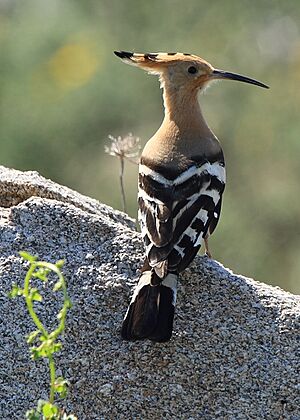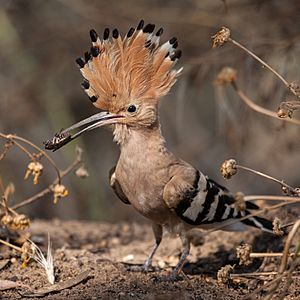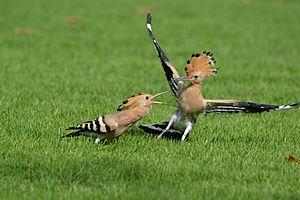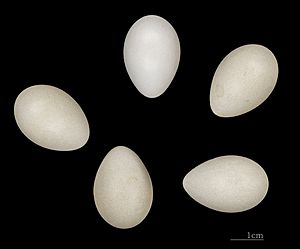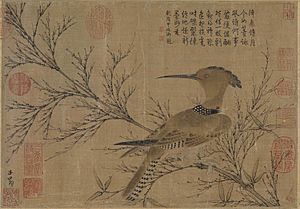Hoopoe facts for kids
Quick facts for kids Hoopoe |
|
|---|---|
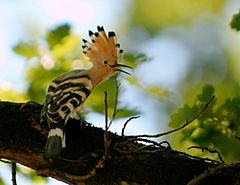 |
|
| Conservation status | |
| Scientific classification | |
| Kingdom: | |
| Phylum: | |
| Class: | |
| Order: | |
| Family: |
Upupidae
Leach, 1820
|
| Binomial name | |
| Upupa epops Linnaeus, 1758
|
|
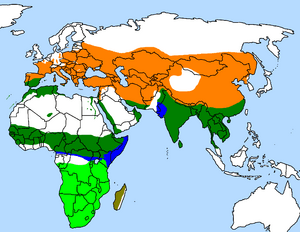 |
|
| Approximate range | |
The Hoopoe (Upupa epops) is a very colourful bird. It lives across Afro-Eurasia. People know it for the special 'crown' of feathers on its head.
It is the only living bird in its family, called Upupidae. There was once a Giant Hoopoe on Saint Helena island, but it is now extinct. The Hoopoe from Madagascar is sometimes seen as its own species. The name "Hoopoe" comes from the Latin word upupa. This word sounds like the bird's call.
Contents
What is a Hoopoe?
The Hoopoe belongs to a group of birds called Coraciiformes. This group also includes kingfishers, bee-eaters, and rollers. Scientists believe the Hoopoe is closely related to woodhoopoes. They share some unique features, like a special ear bone.
Hoopoe Types
Scientists recognize nine different types, or subspecies, of Hoopoes. These types mostly look different in their size and the colour of their feathers. For example, some might be a bit bigger or have brighter colours.
Where Hoopoes Live
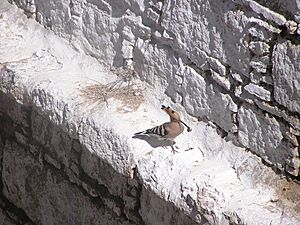
Hoopoes live in many places. You can find them in Europe, Asia, and North Africa. They also live in Sub-Saharan Africa and Madagascar. Most Hoopoes from Europe and northern Asia migrate to warmer places in winter. But Hoopoes in Africa stay in the same place all year.
Sometimes, a Hoopoe might fly far off course. One was seen in Alaska in 1975! Hoopoes have even bred in southern England during warm, dry summers. This is when there are lots of insects for them to eat. However, in the 1980s, their numbers in northern Europe started to drop. This might be because of climate changes.
Hoopoe Homes
Hoopoes need two main things for their home. First, they need open ground with little grass to find food. Second, they need places with holes to build their nests. These holes can be in trees, cliffs, or even walls. They can also use nest boxes or old burrows.
Because of these simple needs, Hoopoes live in many different places. They can be found in grasslands, savannas, and forest clearings. The Hoopoe from Madagascar even lives in thick forests. People changing land for farming has also helped Hoopoes. They are now common in olive groves, orchards, and farmlands. But they are less common in areas with very intense farming. Hunting is a problem for them in southern Europe and Asia.
Hoopoes sometimes move to new areas when it rains in places like Ceylon. Birds have been seen flying very high when migrating over the Himalayas. One Hoopoe was even seen at about 6,400 m (21,000 ft) during the first Mount Everest trip.
Hoopoe Habits
Hoopoes like to sunbathe. They spread their wings and tail low on the ground. They also tilt their heads up. They often fold their wings and clean their feathers while sunbathing. They also enjoy taking baths in dust and sand. Adult Hoopoes might start losing their old feathers after breeding. They continue to do this after they fly south for winter.
What Hoopoes Eat
Hoopoes mainly eat insects. But they also sometimes eat small reptiles, frogs, and even plant parts like seeds and berries. They usually look for food alone on the ground. Sometimes, they will catch insects in the air. Their strong, rounded wings make them fast flyers.
Most often, they walk over open ground. They stop often to poke their long beaks into the soil. They can find insect larvae, pupae, and mole crickets with their beaks. They either pull them out or dig them up with their strong feet. Hoopoes also eat insects on the surface. They will poke into piles of leaves and even use their beaks to lift big stones or peel off tree bark.
Common foods include crickets, locusts, beetles, and ants. These insects can be from 10 to 150 mm long. Hoopoes prefer to eat prey that is about 20–30 mm long. If an insect is too big, they will hit it against the ground or a stone. This kills the insect and removes parts they cannot digest, like wings or legs.
Hoopoe Reproduction
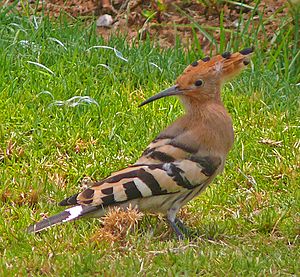
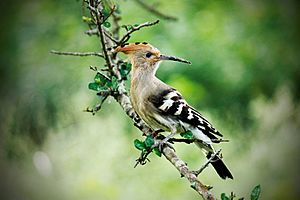
Hoopoes usually have one partner for a breeding season. They also protect their nesting area. The male Hoopoe calls often to show that the territory is his. Males often chase and fight each other, and sometimes females do too. These fights can be rough. Birds try to stab rivals with their beaks. Sometimes, a bird can even be blinded in a fight.
The Hoopoe nest is in a hole in a tree or a wall. It has a small entrance. The nest might not have any lining, or it might have a few scraps of material. Only the female Hoopoe sits on the eggs to keep them warm. The number of eggs changes depending on where the birds live. Birds in the Northern Hemisphere lay more eggs than those in the Southern Hemisphere. Birds farther from the equator also lay more eggs. In central and northern Europe and Asia, a Hoopoe might lay about 12 eggs. In tropical areas, they lay about four eggs, and in subtropical areas, about seven.
The eggs are round and light blue when laid. But they quickly get dirty in the nest. Each egg weighs about 4.5 grams. If the first set of eggs is lost, the female can lay another set.
Hoopoes have special ways to protect their nests from predators. The female Hoopoe, when sitting on eggs, makes a bad-smelling liquid. The baby Hoopoes also make this liquid. They rub this liquid into their feathers. This liquid smells like rotting meat. Scientists think it helps keep predators away. It might also stop parasites and bacteria. The birds stop making this liquid just before the young birds leave the nest.
When they are about six days old, baby Hoopoes can squirt poop at anything that bothers them. They also hiss like snakes. The young birds will also hit intruders with their beak or a wing.
The eggs hatch in about 15 to 18 days. The male Hoopoe feeds the female during this time. The eggs hatch at different times, so some chicks are older than others. When they hatch, the chicks are covered in soft downy feathers. After about three to five days, their adult feathers start to grow. The female Hoopoe keeps the chicks warm for about 9 to 14 days. After that, both parents bring food to the young. The young birds learn to fly in 26 to 29 days. They stay with their parents for about one more week.
Images for kids
See also
 In Spanish: Abubillas para niños
In Spanish: Abubillas para niños



